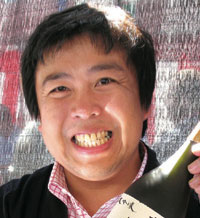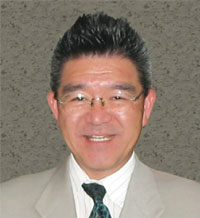What is distilled alcohol?
Distilled alcohol is alcohol used as an additive for Japanese sake. Previously referred to as “alcohol as raw sake ingredient” was renamed as “distilled alcohol” according to the “Standards for Manufacturing Methods and Quality Indication for Sake,” issued in 1990. Alcohol for consumption - the main ingredient for Japanese sake - is mostly starch turned into sugar, and ninety-five percent ethyl alcohol, or liquid remaining after molasses from sugar cane, etc., crystalized and fermented, then vaporized with no synthetic alcohol used. Therefore, according to the label standards, indicating ‘distilled’ clarifies this beverage was not prepared using any synthetic alcohol. Currently, many products often distill and refine crude alcohol imported from overseas. Also, alcohol prepared by distilling shochu and sake lees is also used.
Additives are added to distilled alcohol approximately one to two days before squeezing the fermenting-mash. Leaving for a long time after the additives are added will degrade the sake quality. This method is referred to as “alcohol fortification.” The amount of additives is different according to the targeted sake quality, however, the standard for generic sake is 1t of white rice with thirty-percent alcohol is approximately 500 ~ 600 liters. “Specific class sake,” such as Ginjo and Honjozo, is limited to below ten percent of the weight of white rice (weight of alcohol portion converted at 95 percent).
Distilled alcohol tends to be frowned upon due to its established perception as “alcohol-added sake,” produced using low-quality alcohol post war when rice was short in supply. However, this is not always the case. While it is true that additives are typically added to alcohol to increase the volume for regular sake, for certain sake brands, these additives are used as a technique to achieve a smooth sake quality. An appropriate amount of additives enhances the sake flavor and aroma, thus these additives are used in Ginjo sake, known as the crown jewel of Japanese sake. Adding alcohol is what draws out the fruity Ginjo aroma, for without alcohol, the aroma will be left stronger on the strained sake lees. In other words, the Ginjo aroma is more faint in the Junmai-type Ginjo.
By the way, the limit set to the amount of additives in distilled alcohol of a specific brand name sake is the upper limit, with the actual amount of additives used being less than half of the limit in most cases. This is because the additives are not used for the purpose to increase volume, but to enhance the sake quality.
Additives are added to distilled alcohol approximately one to two days before squeezing the fermenting-mash. Leaving for a long time after the additives are added will degrade the sake quality. This method is referred to as “alcohol fortification.” The amount of additives is different according to the targeted sake quality, however, the standard for generic sake is 1t of white rice with thirty-percent alcohol is approximately 500 ~ 600 liters. “Specific class sake,” such as Ginjo and Honjozo, is limited to below ten percent of the weight of white rice (weight of alcohol portion converted at 95 percent).
Distilled alcohol tends to be frowned upon due to its established perception as “alcohol-added sake,” produced using low-quality alcohol post war when rice was short in supply. However, this is not always the case. While it is true that additives are typically added to alcohol to increase the volume for regular sake, for certain sake brands, these additives are used as a technique to achieve a smooth sake quality. An appropriate amount of additives enhances the sake flavor and aroma, thus these additives are used in Ginjo sake, known as the crown jewel of Japanese sake. Adding alcohol is what draws out the fruity Ginjo aroma, for without alcohol, the aroma will be left stronger on the strained sake lees. In other words, the Ginjo aroma is more faint in the Junmai-type Ginjo.
By the way, the limit set to the amount of additives in distilled alcohol of a specific brand name sake is the upper limit, with the actual amount of additives used being less than half of the limit in most cases. This is because the additives are not used for the purpose to increase volume, but to enhance the sake quality.
醸造アルコールとは何か
醸造アルコールとは、日本酒のアルコール添加用として使用されるアルコールのことである。以前は「原料用アルコール」と表現されていたが、平成2年に施行された「清酒の製法品質表示基準」によって、「醸造アルコール」と表示されることになった。日本酒の原料用アルコールは、主にでんぶん質を糖化したものや、廃糖蜜(サトウキビやテンサイなどの糖蜜から砂糖を結晶させた後に残る液)を発酵させた後に蒸留して造られる95%のエチルアルコールであり、いわゆる合成アルコールなどはいっさい使用されていない。そこで、表示基準では「醸造」と標記することで、合成アルコールではないということを明確にしているわけである。現在は、海外から輸入した粗留アルコールを蒸留精製することが多い。また、焼酎や清酒粕を蒸留したアルコールも用いられる。
醸造アルコールの添加は、通常、もろみを搾る1~2日前に行なわれる。添加してから長く放置すると酒質が劣化するためである。この方法を「アルコール添加」(略して「アル添」)という。添加量は目標とする酒質により異なるが、普通酒の場合で、白米1t当たり30%アルコールを500~600リットル程度が標準とされる。吟醸酒や本醸造酒などの「特定名称酒」の場合は、白米重量の10%以下(アルコール分95%換算の重量)に制限されている。
醸造アルコールというと、原料米が極端に不足した戦中戦後の時代に編み出された「アル添酒」や三増酒」のイメージから眉をしかめる向きもあるが、必ずしもそうではない。アルコール添加は、普通酒の場合はたんなる増量のためであることが多いのは事実だが、特定名称酒の場合は、淡麗・軽快な酒質を造る技術として用いられており、適度な添加は酒の風味をととのえ、香りを高める働きをする。日本酒の最高峰といわれる吟醸酒にも使われているのはそのためである。アルコールを添加するからこそ、あのフルーティーな吟醸香が引き出されるのであり、アルコールを入れないと、搾り粕のほうにより多く香りが残ってしまう。つまり、純米タイプの吟醸酒は、吟醸香が立ちにくいということでもある。
ちなみに、特定名称酒の醸造アルコール添加量の制限は上限であり、実際にはその半分以下であることが多いという。増量ではなく、あくまで酒質を高めることが目的だからである。
醸造アルコールの添加は、通常、もろみを搾る1~2日前に行なわれる。添加してから長く放置すると酒質が劣化するためである。この方法を「アルコール添加」(略して「アル添」)という。添加量は目標とする酒質により異なるが、普通酒の場合で、白米1t当たり30%アルコールを500~600リットル程度が標準とされる。吟醸酒や本醸造酒などの「特定名称酒」の場合は、白米重量の10%以下(アルコール分95%換算の重量)に制限されている。
醸造アルコールというと、原料米が極端に不足した戦中戦後の時代に編み出された「アル添酒」や三増酒」のイメージから眉をしかめる向きもあるが、必ずしもそうではない。アルコール添加は、普通酒の場合はたんなる増量のためであることが多いのは事実だが、特定名称酒の場合は、淡麗・軽快な酒質を造る技術として用いられており、適度な添加は酒の風味をととのえ、香りを高める働きをする。日本酒の最高峰といわれる吟醸酒にも使われているのはそのためである。アルコールを添加するからこそ、あのフルーティーな吟醸香が引き出されるのであり、アルコールを入れないと、搾り粕のほうにより多く香りが残ってしまう。つまり、純米タイプの吟醸酒は、吟醸香が立ちにくいということでもある。
ちなみに、特定名称酒の醸造アルコール添加量の制限は上限であり、実際にはその半分以下であることが多いという。増量ではなく、あくまで酒質を高めることが目的だからである。




